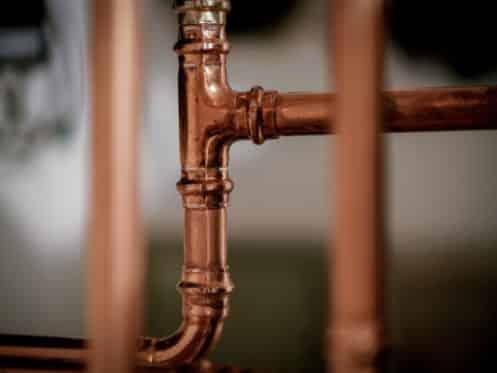Your plumbing system plays an important role by allowing the waste and wastewater from your toilets, sinks, and other fixtures to drain out of your home. The plumbing stack is one of the most important parts of this system. If there are any issues with the plumbing stack, it can prevent your sewer system from working. With this in mind, let’s take a closer look at what the plumbing stack is and how it functions.
What Is a Plumbing Stack?
The plumbing stack is a long pipe that runs vertically from the top to the bottom of the home. All drains in the building connect to the plumbing stack, which connects in turn to the horizontal sewer lateral outside of the home. That carries waste out to the municipal sewer main.
The very bottom of the plumbing stack is known as the soil stack. This is a small section of pipe that runs through the foundation where it then makes a 90-degree bend and ties into the horizontal sewer lateral. It sticks up just above the top of your basement floor where it ties into the middle section of the stack. If your home is built on a concrete slab instead of a foundation, the soil stack connects to the sewer line underneath the slab.
The middle section is known as the drain stack, and this is where the pipes from every drain in the home tie in. The top section of the pipe is known as the vent stack. This runs vertically from the top floor of the building through the attic and then extends above the roof.
International Building Code requires that all buildings have at least one vent stack that must extend at least six inches above the roof. Each toilet has a vent pipe that runs from the drain and extends up through the wall. These typically tie together into the main vent stack in the attic. However, depending on the size of the home and the location of the bathrooms and other plumbing fixtures, there may be more than one vent stack sticking up through the roof.
How Does the Drain Stack Work?
The drain stack is one of the most important parts of your plumbing system. Whenever you use your sink, the water flows down the drain, through the drain line and into the drain stack. Your shower drain, dishwasher, washing machine, and floor drains also tie into the drain stack.
How Does the Vent Stack Work?
The vent stack extends above all of your drains, which means that no waste flows through this section of pipe. Instead, the vent stack serves two other important purposes. The first is that it draws air into the plumbing system.
If the drain stack were to be sealed off at the top, the lack of airflow would cause a vacuum to form inside the pipes. This vacuum would prevent wastewater from draining properly and cause it to get stuck inside the drain lines. Whenever you flush a toilet or put water down the drain, it changes the air pressure inside the vent lines. This results in air getting sucked through the vent stack and into the drain system.
The vent stack also works by venting sewer gases out of the plumbing system. These gases are always present inside your pipes. When your plumbing isn’t in use, the gases are trapped inside the drain line. This happens because the water inside the bend of the drain’s P-trap creates a seal that prevents the gases from escaping and wafting up through the drain. Whenever you use your sink, the force of the water pushes the gases down through the drain line and into the vent stack.
Every drain line connects to the drain stack with a special tee fitting. The bottom of the tee has a slight angle that allows wastewater and solids to easily flow out and into the drain stack. This design creates a slight air gap at the top of the drain line. Due to this gap, the wastewater flows down while any sewer gases rise up and out through the vent stack.
Signs That Indicate the Plumbing Stack Is Clogged or Needs Repair
Most plumbing clogs occur either in individual drain lines or in the horizontal sewer line. Since the drain stack runs vertically, it usually shouldn’t get clogged since gravity forces any solids or wastewater down through the pipe. However, if you put too much toilet paper down the toilet, it can sometimes clog the tee where the drain line meets the vent stack.
Clogs can also occur due to flushing other solids down the toilet or drain. This is especially common if you flush solids like paper towels, wet wipes, feminine hygiene products, diapers, condoms, or really anything other than toilet paper. Still, the biggest issue is when you put oil, fat, or grease down the drain. These can solidify and begin to collect on the inside of the drain lines, drain stack, or your main sewer line. When this happens, the sticky mess inside the pipes can grab hold of other solids and begin to cause a clog. Most commonly, these clogs will occur at the joint where the soil stack meets the sewer line.
If your drains are slower than normal or you hear bubbling or gurgling noises from your pipes or drains, this indicates that there is a partial blockage either in the drain line, plumbing stack, or sewer line. If this issue isn’t taken care of, the pipe will eventually become completely blocked. If this occurs in the plumbing stack or sewer line, it can cause sewage to back up inside your home.
Smelling sewage odors inside your house is potentially a more serious issue that could indicate your plumbing stack is leaking. If this is the case, you will need to immediately have a plumber repair or replace the damaged part of the stack.
The vent stack on your roof can also become clogged with dirt and debris. Most, but not all, homes have a cover over the top of the pipe that helps to prevent leaves and other debris from getting inside the pipe. If the vent stack gets clogged, it can prevent waste from draining out through the sewer line and cause it to back up through your drains. A clogged vent stack can also make your plumbing fixtures drain slowly or cause your sink to not drain at all.
If the vent stack is clogged, it can also result in the water getting sucked out of your P-traps whenever you flush your toilet. Since no air can get in through the plumbing stack, the pressure caused by flushing the toilet will pull air in through your drains and suck the water out of the bend in the P-trap. When this happens, you will usually smell sewage odors coming from the drain since there is no water in the P-trap to seal the gases inside the drain pipe.
The solution to any of these clogging issues is to have a plumber inspect your plumbing stack and sewer line to determine where the clog is. If the vent stack is clogged, they will need to go on the roof and run a plumber’s snake down through the vent pipe to clear out any obstructions. If the soil stack or sewer line is clogged, the plumber will run the snake through your main sewer cleanout.
Some older homes don’t have a sewer cleanout. In this case, it will be necessary to access the plumbing either through the vent stack on the roof or by removing a toilet and going down through the toilet drain in the floor.
Turn to Your Local Experts
If you’re experiencing any drainage issues or problems with your plumbing stack, AJ Danboise Plumbing, Heating, Cooling & Electrical is here to help. We offer professional drain cleaning services and plumbing repairs, and we also work on sump pumps, water filtration systems, garbage disposals, and water heaters. In fact, you can rely on us for a complete line of plumbing services. We also have a team of licensed electricians that can handle any electrical repairs, inspections, or replacements. They install and service whole-home surge protectors, whole-home generators, and other electrical fixtures like lights, ceiling fans, and outlets. In addition, we specialize in HVAC and indoor air quality services including AC, furnace, and boiler installation, maintenance, and repairs. We’ve been doing this since 1925, so if you need any plumbing, electrical, or HVAC service in the Farmington Hills area, contact our team at AJ Danboise Plumbing, Heating, Cooling & Electrical today.


